Teochew cuisine
Teochew cuisine, also known as Chiuchow cuisine, Chaozhou cuisine or Chaoshan cuisine, originated from the Chaoshan region in the eastern part of China's Guangdong Province, which includes the cities of Chaozhou, Shantou and Jieyang. Teochew cuisine bears more similarities to that of Fujian cuisine, particularly Southern Min cuisine, due to the similarity of Chaoshan's and Fujian's culture, language, and their geographic proximity to each other.[1] However, Teochew cuisine is also influenced by Cantonese cuisine in its style and technique.[1]
| Chaozhou cuisine | |||||||||||
|---|---|---|---|---|---|---|---|---|---|---|---|
| Chinese | 潮州菜 | ||||||||||
| |||||||||||
| Chaoshan cuisine | |||||||||||
| Chinese | 潮汕菜 | ||||||||||
| |||||||||||
 |
| Chinese cuisine |
|---|
|
Background
Teochew cuisine is well known for its seafood and vegetarian dishes. Its use of flavouring is much less heavy-handed than most other Chinese cuisines and depends much on the freshness and quality of the ingredients for taste and flavour. As a delicate cuisine, oil is not often used in large quantities and there is a relatively heavy emphasis on poaching, steaming and braising, as well as the common Chinese method of stir-frying. Teochew cuisine is also known for serving congee (糜; mí; or mue), in addition to steamed rice or noodles with meals. The Teochew mue is rather different from the Cantonese counterpart, being very watery with the rice sitting loosely at the bottom of the bowl, while the Cantonese dish is more a thin gruel.
Authentic Teochew restaurants serve very strong oolong tea called Tieguanyin in very tiny cups before and after the meal. Presented as gongfu tea, the tea has a thickly bittersweet taste, colloquially known as gam gam (甘甘; gān gān).
A condiment that is popular in Fujian and Taiwanese cuisine and commonly associated with cuisine of certain Teochew groups is shacha sauce (沙茶酱; 沙茶醬; shāchá jiàng). It is made from soybean oil, garlic, shallots, chilies, brill fish and dried shrimp. The paste has a savoury and slightly spicy taste. As an ingredient, it has multiple uses: as a base for soups, as a rub for barbecued meats, as a seasoning for stir-fried dishes, or as a component for dipping sauces.
In addition to soy sauce (widely used in all Chinese cuisines), the Teochew diaspora in Southeast Asia use fish sauce in their cooking. It is used as a flavouring agent in soups and sometimes as a dipping sauce, as in Vietnamese spring rolls.
Teochew chefs often use a special stock called superior broth (上汤; 上湯; shàngtāng). This stock remains on the stove and is continuously replenished. Portrayed in popular media, some Hong Kong chefs allegedly use the same superior broth that is preserved for decades. This stock can as well be seen on Chaozhou TV's cooking programmes.
There is a notable feast in Teochew cuisine called jiat dot (食桌; shízhuō; 'food table'). A myriad of dishes are often served, which include shark fin soup, bird's nest soup, lobster, steamed fish, roasted suckling pig and braised goose.
Teochew chefs take pride in their skills of vegetable carving, and carved vegetables are used as garnishes on cold dishes and on the banquet table.
Teochew cuisine is also known for a late night meal known as meh siao (夜宵; yèxiāo) or daa laang (打冷; dǎléng) among the Cantonese. Teochew people enjoy eating out close to midnight in restaurants or at roadside food stalls. Some dai pai dong-like eateries stay open till dawn.
Unlike the typical menu selections of many other Chinese cuisines, Teochew restaurant menus often have a dessert section.
Many people of Chaoshan origin, also known as Teochiu or Teochew people, have settled in Hong Kong and places in Southeast Asia like Malaysia, Singapore, Cambodia and Thailand. Influences they bring can be noted in Singaporean cuisine and that of other settlements. A large number of Teochew people have also settled in Taiwan, evident in Taiwanese cuisine.[2] Other notable Teochew diaspora communities are in Vietnam, Cambodia and France. A popular noodle soup in both Vietnam and Cambodia, known as hu tieu, originated from the Teochew.[3] There is also a large diaspora of Teochew people (most were from Southeast Asia) in the United States - particularly in California. There is a Teochew Chinese Association in Paris called L'Amicale des Teochews en France.
Notable dishes
| English | Traditional Chinese | Simplified Chinese | Pinyin | Teochew transliteration | Description |
|---|---|---|---|---|---|
| Bak chor mee | 肉碎麵 | 肉碎面 | ròusuì miàn | bak chor mee | Boiled noodles, dried and mixed with variety sauce such as soy sauce, chilli sauce and lard topped with vegetables, sliced onion, minced pork, mushrooms and fish balls or fishcakes. |
| Bak kut teh | 肉骨茶 | 肉骨茶 | ròugǔchá | bak kut teh | A hearty soup that, at its simplest, consists of meaty pork ribs in a complex broth of herbs and spices (including star anise, cinnamon, cloves, danggui, fennel seeds and garlic), boiled together with pork bones for hours. Dark and light soy sauce may also be added to the soup during the cooking stages. Some Teochew families like to add extra Chinese herbs such as yuzhu (rhizome of Solomon's Seal) and juzhi (buckthorn fruit) for a sweeter, slightly stronger flavoured soup. The dish is usually eaten with rice or noodles (sometimes as a noodle soup), and often served with youtiao. Garnish includes chopped coriander or green onions and a sprinkling of fried shallots. A variation of bak kut teh uses chicken instead of pork, which then becomes chik kut teh. Bak kut teh is particularly popular in Southeast Asian countries such as Singapore and Malaysia. |
| Braised varieties | 滷味 | 卤味 | lǔwèi | lo bah | Teochew cuisine is noted for its variety of braised dishes, which includes geese, duck, pork, bean curd and offal. |
| Chai tau kueh | 菜頭粿 | 菜头粿 | càitóu guǒ | chai tau kueh | A savoury fried cake, made of white radish and rice flour. It is commonly stir-fried with soy sauce, eggs, garlic, spring onion and occasionally dried shrimp. |
| Sichuan pepper chicken | 川椒雞 | 川椒鸡 | chuān jiāo jī | cuêng ziê goi | A deep-fried chicken dish, usually accompanied with leafy green from lysimachia clethroides, known as pearl vegetable (珍珠菜). However, lysimachia clethroides's leaves are unavailable to use in culinary outside of China, but basil, spinach, or other leafy green vegetables can be substitutes to them in preparation of the dish.[4] |
| Chwee kueh | 水粿 | 水粿 | shuǐguǒ | chwee kueh | Cup-shaped steamed rice cakes topped with chopped preserved/salted radish. |
| Crystal balls | 水晶包 | 水晶包 | shuǐjīng bāo | zhui jia bao | A steamed dessert with a variety of fillings such as yellow milk (奶黄; 奶黃; nǎihuáng; ni ng), yam paste (芋泥; yùní; or ni) or bean paste made from mung beans or azuki beans. They are similar to mochi. |
| Fish balls / fishcakes / fish dumplings | 魚丸 / 魚粿 / 魚餃 | 鱼丸 / 鱼粿 / 鱼饺 | yúwán / yúguǒ / yújiǎo | her ee / her kueh / her kiaw | This fish paste made into balls, cakes and dumplings can be cooked in many ways but are often served in Teochew-style noodle and soups. |
| Flavored-Potted Goose | 滷水鵝 | 卤水鹅 | lǔ shuǐ é | lou zui gho | A well-known braised goose dish, often accompanised by tofu. |
| Fried Bean Curd | 炸豆腐 | 炸豆腐 | zhà dòufu | za dao hu | A simple deep fried tofu dish, and was later adopted by Guangzhou's residents. First, deep-fry slices of fresh firm tofu until they are golden, and then serve with salted water dip (ingredients are boiling water, salt, and chopped Chinese chives).[5] In modern times, some Teochew people now use the air fryer to prepare them for convenience and reduction of the amount of fat and calories in the food. |
| Fried beef balls | 炸牛肉丸 | 炸牛肉丸 | zhà niúròu wán | za ghu bak ee | A simple deep-fired beef ball dish serves with dipping sauce such as shacha sauce or salted water dip (ingredients are boiling water, salt, and chopped Chinese chives). In modern times, some Teochew people now use the air fryer to prepare them for convenience and reduction of the amount of fat and calories in the food. |
| Fish ball noodle soup | 魚丸麵 | 鱼丸面 | yúwán miàn | her ee mee | Any of several kinds of egg and rice noodles may be served either in a light fish-flavoured broth or dry, along with fishballs, fishcakes, beansprouts and lettuce. |
| Fun guo | 粉餜 | 粉馃 | fěnguǒ | hung gue | A type of steamed dumplings. This is usually filled with dried radish, garlic chives, ground pork, dried shrimp, Shiitake mushrooms and peanuts. The dumpling wrapper is made from a mixture of flour or plant starches mixed together with water. In Cantonese, these are called chiu chow fun guo (潮州粉果; Cháozhōu fěnguǒ), in which the Chinese character 餜 is replaced by 果. |
| Head Mustard with Mushrooms | 厚菇大芥菜 | 厚菇大芥菜 | hòugū dà jiècài | gao gou dua gai cai | A dish of brassica juncea (Chinese mustard) and shiitake (Chinese black mushrooms) in a soup. Originally a vegetarian soup, it often added with diced pork belly and other ingredients. |
| Kueh chap | 粿汁 | 粿汁 | guǒzhī | kueh chap | A dish of flat, broad rice sheets in a soup made from dark soy sauce served with pig offal, braised duck meat, various kinds of bean curd, preserved salted vegetables and braised hard-boiled eggs. |
| Mee pok | 麵薄 | 面薄 | miànbáo | mee pok | A popular noodle dish served with minced pork, braised mushrooms, fishballs, dumplings, sauce and other garnish. |
| Oolong tea | 烏龍茶 | 乌龙茶 | wūlóng chá | Ou-leeng teh | Tieguanyin is one of the most popular Teochew teas. However, the Teochew people prefer their own brand of Oolong tea, which is the hong wang dan cong teh (凤凰单丛茶; 鳳凰單丛茶; fènghuáng dāncóng chá). |
| Oyster omelette | 蠔烙 | 蠔烙 | háolào | or lua | A dish of omelette cooked with fresh raw oysters,tapioca starch and eggs. Teochew-style oyster omelette is usually deep fried and very crisp. Dip condiments are fish sauce and pepper or chili sauce. |
| Pan-fried Marinated Fish | 烳醃魚 | 烳腌鱼 | pǔyānyú | pu iem he | A pan-fried dish of marinated fish, typically using a larimichthys crocea as the main ingredient but can use other alternatives such as a white croaker, Japanese sea bass or other types of bass, or tilefish. |
| Patriotic soup (Protect the Country Dish) | 護國菜 | 护国菜 | hùguó cài | hu gog chai | Developed during the Mongol conquest of the Song dynasty and named by Song's last emperor Zhao Bing. A simple soup boiled with stir-fried leaf vegetable (commonly sweet potato leaves since the Ming dynasty but also can use amaranth, spinach, ipomoea aquatica or other leafy greens as alternatives) and edible mushrooms (preferably straw mushrooms) and broth (vegetable, chicken, or beef). |
| Pig's organ soup | 豬雜湯 | 猪杂汤 | zhūzátāng | ter zap terng | |
| Popiah | 薄餅仔 | 薄饼仔 | báobǐngzǎi | po piah | A fresh (non-fried) spring roll usually eaten during the Qingming Festival. The skin is a soft, thin paper-like crepe made from wheat flour. The filling is mainly finely grated and steamed or stir-fried turnip, yam bean (jicama), which has been cooked with a combination of other ingredients such as bean sprouts, French beans, and lettuce leaves, depending on the individual vendor, along with grated carrots, slices of Chinese sausage, thinly sliced fried tofu, chopped peanuts or peanut powder, fried shallots and shredded omelette. Other common variations of popiah include pork (lightly seasoned and stir-fried), shrimp or crab meat. It is eaten in accompaniment with a sweet sauce (often a bean sauce, a blended soy sauce or hoisin sauce or a shrimp paste sauce). |
| Pork jelly | 豬腳凍 | 猪脚冻 | zhūjiǎo dòng | ter ka dang | Braised pig's leg made into jelly form, sliced and served cold. |
| Prawns Sautéed with Olive Vegetables | 欖菜焗蝦 | 榄菜焗虾 | lǎncàijúxiā | lam cai ju he | A dish of deep-fried prawns |
| Salted vegetable duck soup | 鹹菜鴨湯 | 咸菜鸭汤 | xiáncài yātāng | kiam cai ak terng | A soup boiled with duck, preserved salted vegetable, tomatoes and preserved sour plum. |
| Spring rolls with prawn or minced meat fillings | 蝦卷 / 燒卷 / 五香 | 虾卷 / 烧卷 / 五香 | xiājuǎn / shāojuǎn / wǔxiāng | heh gerng / sio gerng / ngo hiang | Mixed pork and prawn paste (sometimes fish), seasoned with five-spice powder, wrapped and rolled in a bean curd skin and deep-fried or pan-fried. It is sometimes referred to as Teochew-style spring roll in restaurant menus. |
| Steamed chives dumplings | 韭菜餜 | 韭菜馃 | jiǔ cài guǒ | gu chai gue | They are sometimes sautéed to give them a crispy texture. |
| Steamed goose | 炊鵝 | 炊鹅 | chuī é | chue gho | |
| Taro paste | 芋泥 | 芋泥 | yùní | orh ni / orh nee | A traditional Teochew dessert made primarily from taro. The taro is steamed and then mashed into a thick paste, which forms the base of the dessert. Pumpkin is also added for sweetness and to create a smoother consistency. Lard or fried onion oil is then added for fragrance. The dessert is traditionally sweetened with water chestnut syrup, and served with ginkgo nuts. Modern versions of the dessert include the addition of coconut cream and sweet corn. The dessert is commonly served at traditional Teochew wedding banquet dinners as the last course, marking the end of the banquet. |
| Teochew chicken | 潮州雞 | 潮州鸡 | Cháozhōu jī | Teochew koi | A dish of sliced chicken |
| Teochew cold crab | 潮州凍蟹 | 潮州冻蟹 | Cháozhōu dòngxiè | Teochew ngang hoi | The whole crab is first steamed then served chilled. The species of crab most commonly used is Charybdis cruciata. |
| Teochew hot pot / Teochew steamboat | 潮州火鍋 | 潮州火锅 | Cháozhōu huǒguō | Teochew zuang lou | A dish where fresh, thinly sliced ingredients are placed into a simmering flavourful broth to cook and then dipped into various mixed sauces, usually with Shacha and soy sauce as its main components. Ingredients often include leafy vegetables, yam, tofu, pomfret and other seafood, beef balls, fish balls, pork balls, mushrooms and Chinese noodles, among others. Teochew hot pot, like other Chinese hot pots, is served in a large communal metal pot at the center of the dining table. |
| Teochew rice noodle soup | 潮州粿條 | 潮州粿条 | Cháozhōu guǒtiáo | Teochew kuay teow | A quintessential Teochew-style noodle soup that is also particularly popular in Vietnam and Cambodia (known respectively as hu tieu and kuy teav), through the influx of Teochew immigrants. It is a dish of yellow egg noodles and thin rice noodles served in a delicate, fragrant soup with meatballs, other various meats, seafood (such as shrimp), fried fishcake slices, quail eggs, blanched Chinese cabbage and sometimes offal. The soup base is typically made of pork or chicken bones and dried squid. Just before serving, the noodle soup is garnished with fried minced garlic, fried shallots, thinly sliced scallions and fresh cilantro (coriander) sprigs. For those who enjoy their noodle soup with added depth, the solid ingredients may be dipped into Shacha sauce or Teochew chilli oil. |
| Teochew-style congee | 潮州糜 | 潮州糜 | Cháozhōu zhōu | Teochew mue | A rice soup that has a more watery texture as compared to the Cantonese congee. It is commonly served with various salty accompaniments such as salted vegetables (kiam chai), preserved radish (chai por), boiled salted duck eggs, fried salted fish and fried peanuts. |
| Teochew-style steamed pomfret | 潮州蒸鯧魚 | 潮州蒸鲳鱼 | Cháozhōu zhēng chāngyú | Teochew chue chioh her | Silver pomfret steamed with preserved salted vegetables, lard and sour plums. |
| Yusheng | 魚生 | 鱼生 | yúshēng | her sae | A raw fish salad where typical ingredients include: fresh salmon, white radish, carrot, red pepper (capsicum), ginger, kaffir lime leaves, Chinese parsley, chopped peanuts, toasted sesame seeds, Chinese shrimp crackers or fried dried shrimp and five spice powder, with the dressing primarily made from plum sauce. It is customarily served as an appetiser to raise 'good luck' for the new year and is usually eaten on the seventh day of the Lunar New Year. |
| Teochew Peach-shaped Kuehe | 红桃粿 | ng tao guoo | ung toh kway | Pink hue rice flour skin wrapped with flavorful glutinous rice. Pressed on a nicely designed peach shaped wooden mould, and then steam the dumpling to perfection. You can eat it freshly steamed, or pan-fried.[6] | |
Gallery
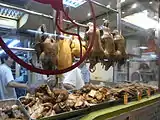 "Flavor potted" goose (滷水鵝)
"Flavor potted" goose (滷水鵝)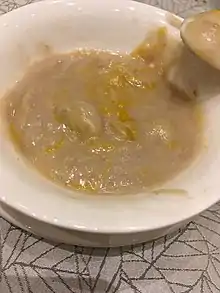 Taro paste (芋泥)
Taro paste (芋泥) Crystal balls (水晶包)
Crystal balls (水晶包)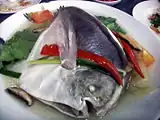 Steamed fish (炊魚)
Steamed fish (炊魚)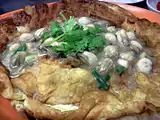 Oyster omelette (蚝烙)
Oyster omelette (蚝烙)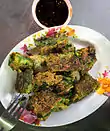 Fried chive dumplings (韭菜餜)
Fried chive dumplings (韭菜餜)_%E5%AE%8B%E6%9C%9D%E7%9A%84%E2%80%9C%E8%AD%B7%E5%9C%8B%E8%8F%9C%E2%80%9D%EF%BC%88%E5%9C%A8%E5%8A%A0%E5%88%A9%E7%A6%8F%E5%B0%BC%E4%BA%9E%E5%85%8B%E6%B4%9B%E7%B6%AD%E6%96%AF%E5%B8%82%E8%A3%BD%E5%82%99%EF%BC%89%E3%80%82.jpg.webp) Patriotic Soup (Protect the Country Dish (護國菜))
Patriotic Soup (Protect the Country Dish (護國菜)).jpg.webp) A dish of fried tofu (炸豆腐) with dipping sauce.
A dish of fried tofu (炸豆腐) with dipping sauce..jpg.webp) Teochew rice noodle soup (潮州粿條).
Teochew rice noodle soup (潮州粿條)..jpg.webp) Sautéed Prawns with Olive Vegetables (欖菜焗蝦) .
Sautéed Prawns with Olive Vegetables (欖菜焗蝦) ._%E6%BD%AE%E5%B7%9E%E7%81%AB%E9%8D%8B%EF%BC%88%E5%9C%A8%E5%8A%A0%E5%88%A9%E7%A6%8F%E5%B0%BC%E4%BA%9E%E5%85%8B%E6%B4%9B%E7%B6%AD%E6%96%AF%E5%B8%82%E8%A3%BD%E5%82%99%EF%BC%89.jpg.webp) Teochew Hotpot (潮州火鍋)
Teochew Hotpot (潮州火鍋)
References
- Chang, Kwang-chih (1977), Food in Chinese culture : anthropological and historical perspectives, Yale University Press
- The globalization of Chinese food. Wu, David Y. H., Cheung, Sidney C. H. Honolulu: University of Hawaiʻi Press. 2002. ISBN 9780824825829. OCLC 48176894.CS1 maint: others (link)
- https://www.asialifemagazine.com/vietnam/teochew-noodles/
- Yin-Fei Lo, Eileen (2009). Mastering the Art of Chinese Cooking. San Francisco: Chronicle Books LLC. pp. 219–221. ISBN 9780811859332.
- Yin-Fei Lo, Eileen (2009). Mastering the Art of Chinese Cooking. San Francisco: Chronicle Books LLC. p. 327. ISBN 9780811859332.
- Mok, Annie (April 5, 2015). "Annielicious Food: TeowChew Png Kueh / TeowChew Glutinous Rice Dumpling (潮州饭粿 / 潮州红桃粄 )". Annielicious Food. Retrieved February 15, 2018.